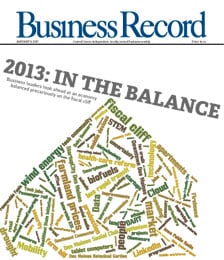Can downtown keep up the pace?

First came the shiny new office buildings. Over the past several years, massive projects such as 801 Grand and the rest of the Principal Financial Group Inc. campus additions, the ultramodern tower built by EMC Insurance Group and the new Allied Insurance headquarters have turned downtown Des Moines into a postcard version of the modern medium-sized city.
Now we’re seeing a downtown residential boom unlike anything the city has witnessed before. If all of the proposed projects succeed, thousands of people will take up residency in a relatively small area.
So what comes next? With our biggest companies settled into large, luxurious headquarters, most downtown sites spoken for, and city government running low on cash to add to private building efforts, is the great era of downtown development coming to an end?
We asked corporate leaders, real estate experts and government officials to peer 10 years into Des Moines’ future. Here are some of the visions they described.
“We’ll see a lot more housing, and the core businesses will keep expanding,” said Rick Tollakson, president and chief operating officer of CB Richard Ellis/Hubbell Commercial. But downtown might not be set aside exclusively for the biggest players. In Tollakson’s view, 5,000 downtown residential units would be enough to revive the area’s small-business scene. “A lot of the small-business people have left downtown; more people living there will bring some of that activity back.”
But Tollakson and a colleague don’t see small business regaining the sizable downtown presence it had just a few years ago.
“The wave that’s happening now is going to continue,” predicted Kyle Gamble, senior vice president at Hubbell Commercial. “The large employers have all made significant money and infrastructure contributions to downtown, they drive the space demands, and they’ll continue to do so into the distant future.”
By definition, downtown is an island. To get much bigger, it has to grow upward, which from now on will usually involve tearing down something that’s in the way. The building boom has taken that route in most of the feasible locations, so fewer options remain.
Nearly all of the parking space is accounted for by city ramps and facilities owned by Principal. The city operates some surface parking lots, but much of that open space is targeted for residential buildings in the current Court Avenue development. Churches own a tiny amount of parking in the north section of the downtown core.
Observers believe that at least a couple of the major players downtown intend to build more space on property that they already own, but those companies haven’t announced any such plans.
Chris Greenfield, president of the Downtown Community Alliance, said he thinks tearing down buildings to make room for new ones would be a mistake. “I think abandoning the historic character of Des Moines really undermines one of its assets,” he said. “Sometimes it’s necessary, but my preference is to keep the historic character.”
Greenfield also noted the architectural trends at work and linked them to the current boom in adapting old Des Moines buildings to new uses. “I think that the transformation you’re seeing in downtown Des Moines right now has to do with corporate preferences in office space, from tall buildings to bigger, more massive buildings,” he said. “For example, in the last 10 years most of the buildings that have been built in downtown have been between six and 12 stories tall. With the exception of the 16-story EMC building, most of the buildings are flatter. What that does to the core of downtown is to force us to look for alternative uses for the older properties, like the Des Moines Building and the Liberty Building, whether it be different office options or even the transformation of some of them into housing.”
Out in the western suburbs, of course, it has been much easier to build. Cornfields present fewer problems than existing structures. Statistics compiled in the current quarter by Frandson, Knapp & Associates tell the story of the battle so far. The office occupancy rate for downtown is exactly the same as in the western suburbs at 91.7 percent. However, the west now has nearly 10 million square feet of office space available, about 850,000 more than the downtown core. And most of that edge appears in the most-desirable Class A category, defined as space in newer buildings that rents for $17 or more per square foot.
Principal CEO J. Barry Griswell said: “Obviously, there is more of a split between the suburbs and downtown, and I think that’s healthy. I think there’s room for both. You look at Wells Fargo and they’ve got part of their growth going downtown and part to the suburbs. So I’m pretty optimistic there’ll be a good balance of growth.”
Like Tollakson, Griswell sees more cement trucks and steel beams headed for the central business core. “There will come a time, I’m sure, when downtown will be more built out, but I think there are a couple more spurts to come before that happens,” he said. “I think that one of the really neat things about Des Moines is that when you have companies that get acquired, the acquiring company likes Des Moines and decides they’re going to stay in Des Moines. I believe our sale of our mortgage business to Citigroup will result in that same kind of commitment to Des Moines and more building.
“It’s hard to predict the future, but my guess is that we have several more growth spurts before we run out of steam, if we ever do.”
“Des Moines is pretty dense downtown,” said Deputy City Manager Rick Clark, “but there are still some opportunities within the core and especially around the core. Along the Martin Luther King bypass, there are vast amounts of land that are not being used.”
The key question for Clark and other city government officials is, will the public be expected to continue chipping in for private projects? “In recent past, the council has stretched pretty far to jump-start projects,” Clark said. “There’s been a lot of injection of public funds, and the city has been a pretty aggressive player. But as we go forward, as the market downtown strengthens, the need for public injections of funds is going to decrease.”
In other words, property taxes generated by the current wave of construction should help pay for less glamorous infrastructure work over the next 10 years. “It’s time for a return on the public investment,” Clark said.
Most small entrepreneurs will continue to look in the East Village and other areas around the city core, in Clark’s opinion, for straightforward economic reasons. “Small business on the west side of the Des Moines River will be a tough thing because land prices go up so much when big companies build in the area. Space is no longer available for three or four dollars a square foot, as it was in the past,” he said.
But Clark doesn’t see these changes as foretelling the end of downtown growth. Quite the opposite. “I think it’s true that it’s an extraordinary period right now, but in a lot of ways, it’s just a platform to jump from,” he said. “A lot of trend lines suggest that we’re entering a new era for downtown Des Moines. We’re seeing an explosion of interest in housing downtown, including projects that adapt existing buildings and don’t take new land.
“And in terms of office construction and corporate expansion, one of the big motivations behind the Gateway West project was to create great locations for large-scale corporate investments. I think the land around the Gateway West Park will be perhaps the best corporate expansion land in the state of Iowa.”
A GOLDEN TRIANGLE BETWEEN THE RIVERS
Iowa farmland is considered expensive when the price gets up around $3,000 an acre, but that’s nothing compared to the staggering value of a square block in downtown Des Moines. When the Polk County assessor’s office adds the dollar figure assigned to the city’s newest and biggest buildings to the value of the land they sit on, the results can be breathtaking, as shown in the top map on this page.






